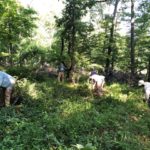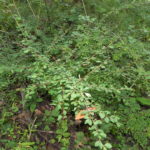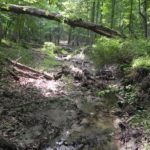Mugging Barberry

It’s a tough task eradicating Barberry.
One pleasant Saturday morning a couple dozen heavily armed people walked to the interior of Faulkes Heritage Woods. Their weapons were those used to help heal the forest and included thick leather gloves, lopping shears, hand saws, and clippers. They were out to defeat Japanese Barberry.
For two hours they attacked a huge patch of Japanese Barberry that had infiltrated the Woods. Grasping small ones with both hands people yanked them from the soil, shook them off and placed them so the roots would dry out and not re-root. In winter, when the Barberry has berries, the plants are placed on tarps and hauled off so the berries do not drop and root. Ones too big to pull were cut off at ground level.
Volunteers were organized by the Iowa Natural Heritage Foundation. It holds a conservation easement on the property that’s owned by the Marion City Parks Department. Park staff helped, and so did a crew of young people enrolled in AmeriCorps. Various local volunteers pulled and cut.
In Its Native Habitat, It is OK.
Just why is Japanese Barberry such an onerous plant? Actually, it’s a fine shrub in Japan and other parts of Asia where it’s native. There it has natural forces that keep its density in check. It was brought to North America as a landscaping plant because barberry is easy to propagate and transplant. It thrives in many locations, including compacted soil of building sites. It is an ideal landscape plant with one terrible trait.

Barberry creates impenetrable tangles and changes the soil chemistry.
The plant produces red fruits in late summer that birds find delicious. They gobble them up, fly away, and poop the seeds out. So, birds snacked on barberries planted in yards and delivered the seeds into Faulkes Woods, where the seeds grow with gusto into impenetrable “pukka brush”.
Barberries crowd out native wildflowers and do much more damage. They actually change the soil chemistry to their advantage while making it less suitable for native plants. And, the dense shrubs create pockets of humidity. Each becomes an oasis of comfort for ticks.
Preserving and Exploring Faulkes Heritage Woods

Many hollows and ravines characterize Faulkes Heritage Woods.
Faulkes Heritage Woods is a gorgeous 110-acre steep forest adjoining Winding Pathways. We walk there often. Huge oaks and other native trees fill its wondrous spaces. Wildflowers abound, especially in the spring, and birding is excellent for woodland species. Pileated woodpeckers are common.
A looping footpath starts and ends at a trailhead off Tama Street Southeast. Visitors can park along the street and enjoy the woods. But, they don’t have to stick to the trail that only covers a small area. Walkers are welcome to go off trail and scramble through the woods to enjoy its beauty and solitude.
For information:
Marion Parks and Recreation: (319)447-3580
Iowa Natural Heritage Foundation: (515)288-1846

